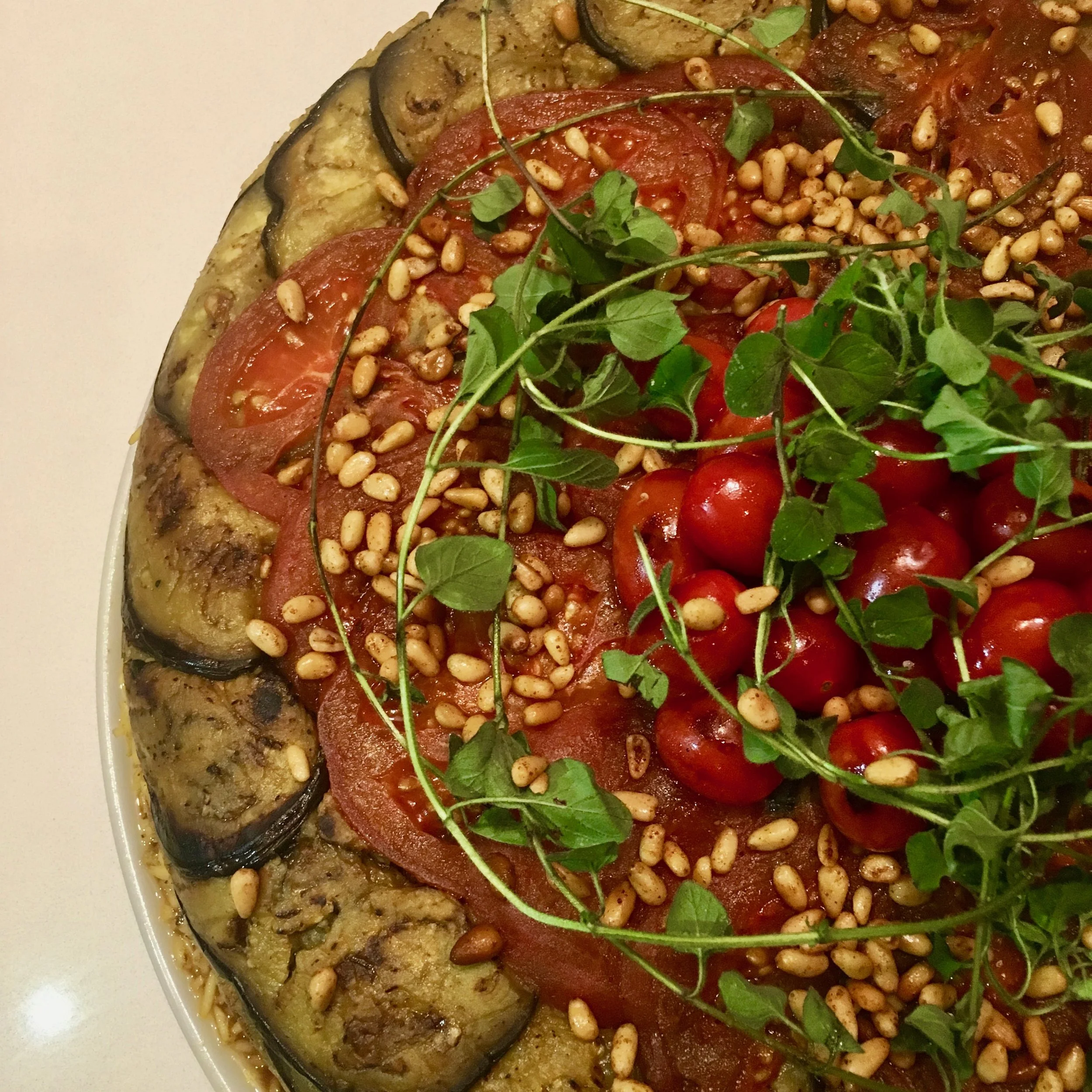As Caren has mentioned, she and I were lucky enough to travel throughout exotic Jordan earlier this year and of course, were on a mission to try all the fabulous local delicacies.
We have already shared a couple of blogs featuring some of the myriad of mezze dishes offered with every generously proportioned meal in Jordan and I would like to share a very typical main course.
Maqlubeh is basically vegetables and, usually, chicken or lamb and rice cooked in well spiced stock. Apart from all the wonderful flavours, what makes Maqlubeh a bit special is that it is all compiled and cooked in one pot and turned out onto a serving platter, in spectacular style, at the table, hopefully still intact.
Our Maqlubeh recipe here uses chicken, however, for a special get together at home I have replaced the chicken with confit of duck, rubbed with middle eastern spices and, while not traditional, it was pretty fabulous.
If you’re not a stickler for tradition, try using our recipe as a benchmark and then go wild with what is available at the market. Just keep the ratio of vegetables and meat to the rice and stock.
Shukraan,
Rosie
MAQLUBEH
Serves 8-10
1 litre quality chicken stock
3 bay leaves
½ teaspoon black peppercorns
1 onion, peeled and roughly chopped
Olive oil for frying and brushing
12 chicken legs
400 gm basmati rice
1 medium cauliflower, cut into large florets
250 gm golden shallots, peeled
3 medium eggplant, cut into 5mm slices
2 teaspoons salt
400 gm cherry tomatoes, washed and dried
40 gm ripe tomatoes, peeled and cut into 5mm slices
4 cloves garlic, roughly chopped
1.5 teaspoons ground turmeric
1.5 teaspoons ground cinnamon
1.5 teaspoons ground allspice
½ teaspoon freshly ground black pepper
1 large pinch chilli flakes, or to taste
2 teaspoons Baharat (see below)
30 gm pinenuts
15 gm unsalted butter
Oregano or parsley leaves for garnish
Pomegranate arils for garnish (optional)
Bring chicken stock to a simmer along with the bay leaves, peppercorns and roughly chopped onion. Simmer, covered, for 20 minutes.
Heat a tablespoon of olive oil in a large frying pan and brown the chicken legs on all sides. You may need to do this in batches. Add the browned chicken legs to the stockpot and poach until just cooked. Remove the legs from the stockpot and when cool enough to handle remove the flesh from the bones. Cut into large chunks and refrigerate until ready to use.
Strain the stock and refrigerate until ready to use.
Preheat the oven to 200°C.
Rinse the rice, place in a bowl with 1 teaspoon of salt. Cover generously with water and allow to stand for 40 minutes.
Toss the cauliflower florets and golden shallots in olive oil, place on an oven tray and bake until golden brown. Turning once or twice. Set aside.
Slice the eggplants into 5mm slices. Sprinkle with the salt, place in a colander and stand for 30 minutes to purge any bitter juices. Place on kitchen paper and pat dry.
Heat a couple of tablespoons of olive oil in a large frying pan and fry the eggplant slices, in batches, adding more olive oil as necessary, until golden brown on both sides. Set aside.
Toss the cherry tomatoes in the frying pan until the skins are beginning to brown. Set aside.
Heat the 15 gm butter in a small frying pan over a medium heat and add the pinenuts. Toss until beginning to brown. Drain, keeping the tasty butter for another use.
Drain the rice.
Take a pan, preferably non-stick with a tight fitting lid, with dimensions somewhere between 24cm diameter x 12cm high and 32cm diameter x 7cm high. (Maqlubeh is traditionally cooked in a high-sided pan, however, as I don’t have a suitably high one I make it successfully in a 32cm x 7cm non-stick pan).
Place overlapping tomato slices on the base of the pan, starting from the centre then arrange the eggplant slices, overlapping, over the top, covering the base of the pan right to the edges, nestle the roasted cauliflower and golden shallots over, dot with half the cherry tomatoes (reserving the remainder for garnish) and finally the place the chicken pieces on top. Scatter with the chopped garlic.
Spread the rice over, pressing down gently.
Add the spices to the stock, stirring well, then gently pour 800ml over the rice. Press down, if the rice is not covered by the stock, add more.
Bring to a boil over a medium heat, cover with a lid and simmer on a very low heat for 20 minutes. Remove the lid and cover with a clean tea towel and replace the lid. Allow to stand for 15 minutes.
Remove the lid and tea towel and place a suitably sized serving dish on top of the pan. Invert the pan and leave it to stand on the plate for a few minutes before taking it to the table, removing the pan and revealing the, hopefully, still intact Maqlubeh.
Garnish the top with the remaining cherry tomatoes, scatter with the toasted pinenuts and parsley or oregano and pomegranate arils if using.
Serve with a bowl of Cucumber with Yoghurt and Mint (see below) and a crisp green salad.
CUCUMBER WITH YOGHURT AND MINT
3 Lebanese cucumbers
600 gm Greek yoghurt, plain, full fat
2 cloves garlic, finely minced
½ bunch fresh mint, finely chopped
1 pinch ground chilli
2 tablespoons lemon juice or to taste
Salt and freshly ground black pepper to taste
Peel the cucumbers and cut into chunks. Combine all other ingredients and fold in the cucumber. Chill before serving.
BAHARAT
Baharat simply means ‘spices’ in Arabic. Different Middle Eastern countries tweak their Baharat mixes a little differently but they are all, essentially, very similar. Baharat is available, pre-mixed, on many spice stands in regular shops in Australia, however, we like to make our own.
Baharat Spice Mix
1 tablespoon black peppercorns
1 tablespoon coriander seeds
2 tablespoons cumin seeds
1 teaspoon whole allspice (pimento)
2 teaspoons whole cloves
1 teaspoon cardamom seeds
2 cinnamon sticks, broken into pieces
3 tablespoons sweet paprika
1 teaspoon freshly ground nutmeg
Finely grind whole spices and cinnamon sticks together in a spice grinder. Transfer to a bowl and thoroughly combine with the ground spices. Store in an airtight container.


